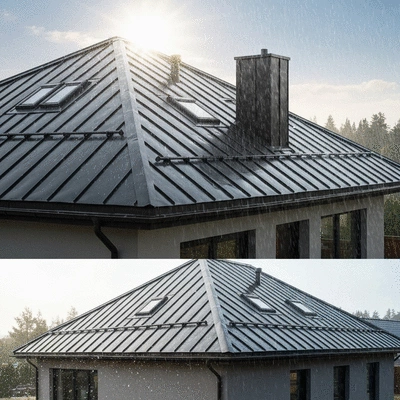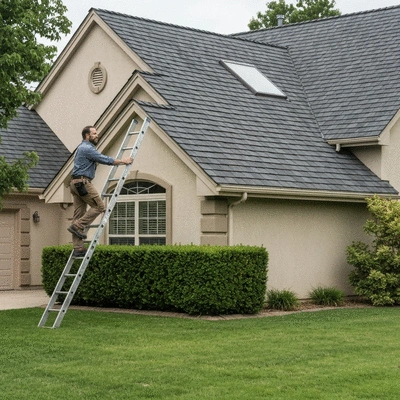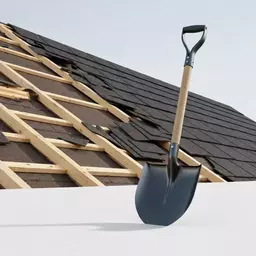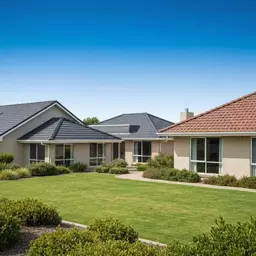Optimal for Hot Climates
- Metal Roofing: Highly reflective.
- Clay Tiles: Good insulation.
- Slate: Natural heat resistance.
(Energy Efficiency Priority)
Get Jordan M. Knox's latest insights on roofing materials, maintenance, and expert tips delivered directly to your inbox. Stay ahead of the curve!
Posted on: 2025-11-15
By: Jordan M. Knox
Have you considered how your roof can affect your home's comfort and energy efficiency? Understanding the interplay between roofing materials and climate is essential for making informed decisions that can save you money and enhance your living experience.
This visual guide outlines optimal roofing material choices across different climates, highlighting key considerations for longevity, maintenance, and energy efficiency. For a deeper dive into the different roof types every homeowner should know, consider exploring detailed comparisons.
(Energy Efficiency Priority)
(Ice Dam Mitigation)
(Proper Ventilation Key)
(Local Codes & Fastening)
When it comes to roofing, one of the most critical yet often overlooked factors is climate. The type of roof you choose can greatly impact its longevity and maintenance needs. For instance, a roof that performs well in a dry, hot climate may not hold up as well in a humid or cold environment. As a seasoned roofing expert, I've seen firsthand how essential it is to align your roofing choices with local weather conditions. Let’s explore why climate matters in roof selection.
Different climates necessitate specific roofing materials. For example, in areas with heavy rainfall, you might want materials that offer superior moisture resistance. On the other hand, regions that experience extreme heat could benefit from roofs that reflect sunlight and minimize heat absorption. Here are some climate-related factors to consider:
By selecting the right roofing material for your climate, you can not only enhance your home's value but also ensure it remains a safe and comfortable environment for years to come.
Understanding roofing materials and their relationship to weather conditions is key to making informed choices. Here are some essential terms to familiarize yourself with:
These terms are crucial when discussing roofing options, especially when considering local climate conditions. It helps to have a solid grasp of these concepts as you navigate your roofing project, perhaps by reviewing a roof maintenance inspection guide.
If you live in a hot climate, selecting the right roofing materials is essential for comfort and energy efficiency. Materials like metal roofing and clay tiles are excellent choices, as they reflect heat and help keep your home cool. Here are some recommended options:
Choosing these materials not only enhances your roof's performance but also contributes to a cooler home, which can lower your energy bills.
In hot regions, energy efficiency becomes a priority. Cool roofs and reflective surfaces are designed to minimize heat absorption and reduce cooling costs. Implementing these technologies can provide a significant savings advantage. Some examples include:
By investing in an energy-efficient roofing system, you not only save money but also contribute to a more sustainable environment.
For those of us situated in colder climates, roofing needs shift significantly. Materials like asphalt shingles and slate are ideal for handling snow and ice. They offer durability and can withstand the freeze-thaw cycles typical of these regions. Here’s what you should consider:
Choosing the right material can help prevent issues such as water infiltration and roof collapse, ensuring your home remains safe and secure.
Ice dams and freeze-thaw cycles can wreak havoc on roofs in snowy areas. Here are some practical tips to mitigate these risks:
Taking these preventive measures can extend the life of your roof and save you from costly repairs down the line.
In wet and humid climates, moisture resistance becomes a top priority. Materials such as concrete tiles are exceptional for their ability to prevent mold and mildew. Here’s a look at materials suited for these environments:
Choosing these materials not only protects your home from water damage but also ensures your roofing remains functional and aesthetically pleasing.
Proper ventilation is crucial in humid climates to avoid mold growth. Here are some practical tips for installation and maintenance:
By focusing on ventilation, you can help prolong your roof's life and enhance its performance, keeping your home safe from moisture-related issues.
Living in an area prone to high winds requires a thoughtful approach to roofing material selection. Impact-resistant materials, like metal roofing, are among the best choices. Here are some materials and styles that work well:
In high-wind zones, it’s essential to choose roofing that can endure the harshest conditions, ensuring your home remains protected.
When selecting a roof in regions prone to hurricanes or severe storms, consider these additional points:
Taking these factors into account can enhance your roof’s performance and protect your home from potential storm damage.
When considering roofing options, it’s important to weigh the advantages and disadvantages of various types. Here’s a quick overview:
By comparing different roof types, you can make an informed decision that suits your specific needs and budget, and explore the pros and cons of various roofing materials in detail.
Proper insulation and ventilation are critical for the durability and energy efficiency of roofs across different climates. Here’s how they impact your roofing:
By acknowledging the importance of insulation and ventilation, you can ensure your roofing remains effective and efficient throughout its lifespan.
When selecting roofing materials for your climate, consider not only the immediate weather conditions but also the long-term effects of local environmental factors. For example, in areas with high humidity, investing in materials with enhanced moisture resistance can prevent mold and premature degradation. Additionally, always check for warranties that cover climate-related damage, ensuring your investment is protected for years to come.
As we dive deeper into the roof selection process, it's essential to reflect on the key points we've discussed about choosing roof types based on climate. Each region presents unique challenges and opportunities when it comes to roofing materials. By understanding local conditions, you can make informed choices that enhance the longevity and performance of your roof.
Climate has a profound effect on the durability and maintenance needs of roofing materials. For instance, hot climates often favor reflective surfaces to combat heat, while cold regions require materials that can withstand heavy snowfall. The takeaway here is that aligning your roof selection with your local climate will not only protect your home but also optimize your investment.
So, what’s next after understanding the relationship between roof types and climate? I encourage you to take a moment and assess your current roof. Consult with professionals who are knowledgeable about local weather conditions and roofing solutions. Tools like our interactive climate-based roof selector can guide you in making informed decisions that suit your specific needs.
Engaging with a qualified contractor is pivotal. They can help ensure that your roof is installed correctly and is compliant with local building codes, which we'll discuss shortly. Don't hesitate to reach out for a consultation! It’s an investment in your peace of mind.
Have you had experiences selecting a roof based on your climate? I’d love to hear from you! Sharing your stories can foster community discussions that benefit all homeowners. For example, did you opt for a metal roof in a hot climate? What was your experience like? These insights can help others navigate their own roofing projects with more confidence.
Your experiences can serve as valuable lessons for others in our community, making the roof selection process a collective learning endeavor.
As we move forward, it’s vital to consider the sustainability of your roofing choices. Eco-friendly materials, such as recycled shingles or solar panels, not only benefit the environment but can also enhance energy efficiency in your home. Incorporating sustainable practices into your roofing decisions can lead to long-term savings and a reduced carbon footprint.
Remember, choosing materials that are both durable and sustainable can significantly impact your home's overall energy efficiency. It’s a win-win situation for both you and the planet!
Finally, let’s talk about local building codes and regulations. These codes are in place to ensure safety and compliance, so it's crucial to understand how they affect your roofing choices. Each region may have specific requirements based on climate, safety standards, and environmental concerns.
By adhering to these regulations, you not only ensure the safety of your home but also facilitate smoother insurance claims in the event of damage. For more insights on this, you might find our article on roofing warranties particularly helpful.
Here is a quick recap of the important points discussed in the article:



 Ever faced the daunting task of removing old roof shingles? The right tool can transform this labor-
Ever faced the daunting task of removing old roof shingles? The right tool can transform this labor-
 Have you ever stopped to think about how your local weather might be silently dictating the lifespan
Have you ever stopped to think about how your local weather might be silently dictating the lifespan
 Have you considered how your roof can affect your home's comfort and energy efficiency? Understandin
Have you considered how your roof can affect your home's comfort and energy efficiency? Understandin